Consideration of Uncertainty and Multiple Disciplines in the Determination of Sustainable Criteria for Rural Roads Using Neutrosophic Logic
Abstract
1. Introduction
2. Materials and Methods
2.1. Main Techniques
2.2. Research Method
2.3. Case Study
3. Results
4. Conclusions
Author Contributions
Funding
Institutional Review Board Statement
Informed Consent Statement
Data Availability Statement
Acknowledgments
Conflicts of Interest
References
- Economic Commission for Latin America and the Caribbean. Rural Roads: Key Roads for the Productivity and Con-Nectivity and the Development. Available online: https://www.cepal.org/es/publicaciones/45781-caminos-rurales-vias-claves-la-produccion-la-conectividad-desarrollo-territorial (accessed on 21 March 2021).
- Economic Commission for Latin America and the Caribbean. Planificación Para el Desarrollo Territorial Sostenible (LC/CRP.17/3). Santiago de Chile, Chile. 2019. Available online: https://www.cepal.org/es/publicaciones/44731-planificacion-desarrollo-territorial-sostenible-america-latina-caribe (accessed on 20 August 2021).
- Pelaez Ponce, A.V.; Pastor Vargas, C.; Gonzalez Rios, C.; Saavedra, E.; Castillo, F.C.; Evia Vizcarra, J.L.; Sour, L.; Mesalles Jorba, L.; Gonzalez, M.; Neri, M.; et al. Inversión en Infraestructura Pública y Reducción de la Pobreza en América Latina. Rio de Janeiro, Brasil. 2011. Available online: https://www.kas.de/c/document_library/get_file?uuid=42349fcb-6292-d816-6965-41fb4a979a53&groupId=252038 (accessed on 1 December 2020).
- Gannon, C.; Lui, Z. Transporte: Infraestructura y Servicios; The World Bank: Washington, DC, USA, 2001. [Google Scholar]
- Technical Committee A.4 Rural Road Systems and Accessibility to Rural Areas. Best Practices for the Sustainable Maintenance of Rural Roads in Developing Countries; World Road Association: Paris, France, 2013; Available online: https://www.piarc.org/en/order-library/19078-en-Best%20practices%20for%20the%20sustainable%20maintenance%20of%20rural%20roads%20in%20developing%20countries (accessed on 1 March 2020).
- Dirección de Vialidad- Ministerio de Obras Públicas Chile. Red Vial Nacional: Dimensionamientos y Características. Reporte Técnico de la Subdirección de Desarrollo. Santiago de Chile, Chile. 2020. Available online: http://www.vialidad.cl/areasdevialidad/gestionvial/Paginas/Informesyestudios.aspx (accessed on 1 March 2021).
- Herrera, M.; Fuenzalida, C.; Tudela, A. Informe final de Evaluación del programa de Caminos Básicos. Reporte de la Direccion de Vialidad Chile. Santiago de Chile, Chile. 2009. Available online: https://www.dipres.gob.cl/597/articles-141136_informe_final.pdf (accessed on 1 December 2020).
- Smith, M.; Gonzalez, S. Evaluación de caminos rurales: Hacia un enfoque orientado al usuario. Rev. de Urban. 2000, 2, 1–15. [Google Scholar] [CrossRef][Green Version]
- Van de Walle, D. Impact evaluation of rural road projects. J. Dev. Eff. 2009, 1, 15–36. [Google Scholar] [CrossRef]
- Contraloría General de la República de Chile. Auditoría de los Procesos Para la Conservación de Caminos, Informe Final N° 501 de 03 Diciembre de 2018. Santiago de Chile, Chile. 2018. Available online: https://www.contraloria.cl/web/cgr/informes-de-auditorias (accessed on 1 December 2020).
- Inter-American Development Bank. Infraestructura Vial y Bienestar Económico: Evaluación de un Programa de Caminos Rurales en la República Dominicana; Informe Técnico OVE/TDP-01/06; Oficina de Evaluación y Supervisión; Republica Dominicana: Santo Domingo, Dominican Republic, 2006. [Google Scholar]
- Sierra, L.A.; Pellicer, E.; Yepes, V. Method for estimating the social sustainability of infrastructure projects. Environ. Impact Assess. Rev. 2017, 65, 41–53. [Google Scholar] [CrossRef]
- Secretaria de Comunicación y Trasporte de México. Caminos Rurales. 2019. Available online: https://www.gob.mx/caminosrurales (accessed on 30 March 2021).
- Shen, L.; Lu, W.; Peng, Y.; Jiang, S. Critical Assessment Indicators for Measuring Benefits of Rural Infrastructure Investment in China. J. Infrastruct. Syst. 2011, 17, 176–183. [Google Scholar] [CrossRef]
- Paredes, G.; Herrera, R. Teaching Multi-Criteria Decision Making Based on Sustainability Factors Applied to Road Projects. Sustainability 2020, 12, 8930. [Google Scholar] [CrossRef]
- World Bank. World-Measuring Rural Access; Update 2017/18 (English); World Bank Group: Washington, DC, USA, 2019; Available online: http://documents.worldbank.org/curated/en/543621569435525309/World-Measuring-Rural-Access-Update-2017-18 (accessed on 30 March 2021).
- Revista Vial. Metodología Para Priorizar una Red Vial de Caminos Rurales—Primera Parte, 130, diciembre. Available online: http://revistavial.com/metodologia-para-priorizar-una-red-vial-de-caminos-rurales/ (accessed on 30 March 2021).
- Revista Vial. Metodología Para Priorizar una Red Vial de Caminos Rurales—Segunda Parte, 131, Diciembre. Available online: http://revistavial.com/metodologia-para-priorizar-una-red-vial-de-caminos-rurales-2/ (accessed on 30 March 2021).
- Sierra, L.A.; Yepes, V.; García-Segura, T.; Pellicer, E. Bayesian network method for decision-making about the social sustainability of infrastructure projects. J. Clean. Prod. 2018, 176, 521–534. [Google Scholar] [CrossRef]
- Esteves, A.M.; Franks, D.; Vanclay, F. Social impact assessment: The state of the art. Impact Assess. Proj. Apprais. 2012, 30, 34–42. [Google Scholar] [CrossRef]
- Navarro, I.; Yepes, V.; Martí, J.V. Sustainability assessment of concrete bridge deck designs in coastal environments using neutrosophic criteria weights. Struct. Infrastruct. Eng. 2019, 16, 949–967. [Google Scholar] [CrossRef]
- Sierra, L.A.; Pellicer, E.; Yepes, V. Social Sustainability in the Lifecycle of Chilean Public Infrastructure. J. Constr. Eng. Manag. 2016, 142, 05015020. [Google Scholar] [CrossRef]
- Beynon, M.J. Analytic Hierarchy Process. In The SAGE Dictionary of Qualitative Management Research; Moutinho, L., Hutcheson, G., Eds.; SAGE Publications Ltd.: Thousand Oaks, CA, USA, 2011; Volume 1, pp. 9–12. [Google Scholar] [CrossRef]
- Smarandache, F. A Unifying Field in Logics; Neutrosophy: Neutrosophic Probability, Set and Logic, 6th ed.; American Research Press: Rehoboth, NM, USA, 2007. [Google Scholar]
- Zavadskas, E.K.; Baušys, R.; Lazauskas, M. Sustainable assessment of alternative sites for the construction of a waste incineration plant by applying WASPAS method with single-valued neutrosophic set. Sustainability 2015, 7, 15923–15936. [Google Scholar] [CrossRef]
- Pamučar, D.; Badi, I.; Sanja, K.; Obradović, R. A Novel Approach for the Selection of Power-Generation Technology Using a Linguistic Neutrosophic CODAS Method: A Case Study in Libya. Energies 2018, 11, 2489. [Google Scholar] [CrossRef]
- Ye, J. Multicriteria decision-making method using the correlation coefficient under single-valued neutrosophic environment. Int. J. Gen. Syst. 2013, 42, 386–394. [Google Scholar] [CrossRef]
- Liang, R.-X.; Wang, J.-Q.; Zhang, H.-Y. A multi-criteria decision-making method based on single-valued trapezoidal neutrosophic preference relations with complete weight information. Neural Comput. Appl. 2018, 30, 3383–3398. [Google Scholar] [CrossRef]
- García-Segura, T.; Penadés-Plà, V.; Yepes, V. Sustainable bridge design by metamodel-assisted multi-objective optimization and decision-making under uncertainty. J. Clean. Prod. 2018, 202, 904–915. [Google Scholar] [CrossRef]
- Enea, M.; Piazza, T. Project Selection by Constrained Fuzzy AHP. Fuzzy Optim. Decis. Mak. 2004, 3, 39–62. [Google Scholar] [CrossRef]
- Biswas, P.; Pramanik, S.; Giri, B.C. TOPSIS method for multi-attribute group decision-making under single-valued neutrosophic environment. Neural Comput. Appl. 2015, 27, 727–737. [Google Scholar] [CrossRef]
- Sodenkamp, M.A.; Tavana, M.; Di Caprio, D. An aggregation method for solving group multi-criteria decision-making problems with single-valued neutrosophic sets. Appl. Soft Comput. 2018, 71, 715–727. [Google Scholar] [CrossRef]
- Chu, T.-C.; Tsao, C.-T. Ranking fuzzy numbers with an area between the centroid point and original point. Comput. Math. Appl. 2002, 43, 111–117. [Google Scholar] [CrossRef]
- Lopez, E.; Monzón, A.; Ortega, E.; Quintana, S.M. Assessment of cross-border spillover effects of national transport infrastructure plans: An accessibility approach. Transp. Rev. 2009, 29, 515–536. [Google Scholar] [CrossRef]
- Sierra, L.A.; Yepes, V.; Pellicer, E. A review of multi-criteria assessment of the social sustainability of infrastructures. J. Clean. Prod. 2018, 187, 496–513. [Google Scholar] [CrossRef]
- Zulaica, L.; Celemín, J.P. Análisis territorial de las condiciones de habitabilidad en el periurbano de la ciudad de Mar del Plata (Argentina), a partir de la construcción de un índice y de la aplicación de métodos de asociación espacial. Rev. Geogr. Norte Grande 2008, 41, 129–146. [Google Scholar] [CrossRef]
- Poch, M.A.; Carvajal, L.G.; Osorio, R.A. Metodología de Identificación de localidades en condición de aislamiento. Un caso de integración de potencialidades de SIG libres y privativos. In Proceedings of the IV Jornadas de Latinoamérica y el Caribe de gvSIG, Cre-Ciendo en Comunidad, Montevideo, Uruguay, 24–26 September 2012; Available online: http://www.subdere.gov.cl/sites/default/files/documentos/zonas_aisladas2.pdf (accessed on 15 February 2021).
- Jeong, J.S.; García-Moruno, L.; Blanco, J.H. Un modelo web para la asistencia en la toma de decisiones en la integración de las construcciones rurales mediante planificación espacial multi-criterio. Informes de la Construcción 2014, 66, e004. [Google Scholar] [CrossRef]
- Bueno, P.; Vassallo, J.M.; Cheung, K. Sustainability Assessment of Transport Infrastructure Projects: A Review of Existing Tools and Methods. Transp. Rev. 2015, 35, 622–649. [Google Scholar] [CrossRef]
- Suprayoga, G.B.; Bakker, M.; Witte, P.; Spit, T. A systematic review of indicators to assess the sustainability of road infrastructure projects. Eur. Transp. Res. Rev. 2020, 12, 1–15. [Google Scholar] [CrossRef]
- Watkins, G.G.; Mueller, S.-U.; Ramirez, M.C.; Meller, H.; Blatsos, I.; De Oliveira, J.C.F.; Casado, C.C.; Georgoulias, A.; Georgoulias, N.; Rodriguez, J. Lessons from Four Decades of Infrastructure Project-Related Conflicts in Latin America and the Caribbean; IDB-MG-549; Inter-American Development Bank: Washington, DC, USA, 2017; 90p. [Google Scholar] [CrossRef]
- Department of Transportation of the United States, Invest. Available online: https://www.sustainablehighways.org/ (accessed on 20 February 2021).
- Diaz-Sarachaga, J.M.; Jato-Espino, D.; Alsulami, B.; Castro-Fresno, D. Evaluation of existing sustainable infrastructure rating systems for their application in developing countries. Ecol. Indic. 2016, 71, 491–502. [Google Scholar] [CrossRef]
- Shen, L.; Jiang, S.; Yuan, H. Critical indicators for assessing the contribution of infrastructure projects to coordinated urban–rural development in China. Habitat Int. 2012, 36, 237–246. [Google Scholar] [CrossRef]
- Mitchard, N.; Frost, L.C.; Harris, J.; Baldrey, S.; Ko, J. Assessing the impact of road schemes on people and communities. Proc. Inst. Civ. Eng.-Eng. Sustain. 2011, 164, 185–196. [Google Scholar] [CrossRef]
- Bonsall, P.; Kelly, C. Road user charging and social exclusion: The impact of congestion charges on at-risk groups. Transp. Policy 2005, 12, 406–418. [Google Scholar] [CrossRef][Green Version]
- Jeon, C.M.; Amekudzi, A.A.; Guensler, R.L. Evaluating Plan Alternatives for Transportation System Sustainability: Atlanta Metropolitan Region. Int. J. Sustain. Transp. 2010, 4, 227–247. [Google Scholar] [CrossRef]
- Yao, H.; Shen, L.; Tan, Y.; Hao, J. Simulating the impacts of policy scenarios on the sustainability performance of infrastructure projects. Autom. Constr. 2011, 20, 1060–1069. [Google Scholar] [CrossRef]
- Curiel-Esparza, J.; Mazario-Diez, J.L.; Canto-Perello, J.; Martin-Utrillas, M. Prioritization by consensus of enhancements for sustainable mobility in urban areas. Environ. Sci. Policy 2016, 55, 248–257. [Google Scholar] [CrossRef]
- Thomopoulos, N.; Grant-Muller, S. Incorporating equity as part of the wider impacts in transport infrastructure assessment: An application of the SUMINI approach. Transportation 2012, 40, 315–345. [Google Scholar] [CrossRef]
- Gilmour, D.; Blackwood, D.; Banks, L.; Wilson, F. Sustainable development indicators for major infrastructure projects. Proc. Inst. Civ. Eng.—Munic. Eng. 2011, 164, 15–24. [Google Scholar] [CrossRef]
- OSE—Observatorio de la Sostenibilidd en España. Patrimonio Natural, Cultural y Paisajistico Claves Para la Sostenibi-Lidad Territorial. Ministerio del Medio Ambiente, Medio Rural y Humano. Madrid España. 2009. Available online: http://www.upv.es/contenidos/CAMUNISO/info/U0556177.pdf (accessed on 30 March 2021).
- Ministerio de Obras Publicas, Chile. Incorporación de Criterios de Sostenibilidad en el Volumen 9 del Manual de Carreteras. Informe Tecnico BID. Santiago de Chile, Chile. 2020. 31p. Available online: https://planeamiento.mop.gob.cl/estudios/Documents/Tercera_Mision_BID/5-Criterios_Sostenibilidad_V9MC_Arrasate.pdf (accessed on 15 March 2021).
- Arroyo, P.; Herrera, R.; Salazar, L.; Giménez, Z.; Martínez, J.; Calahorra, M. Un nuevo enfoque para la integración de factores ambientales, sociales y económicos para evaluar mezclas asfálticas con y sin neumáticos de desecho. Rev. Ing. Constr. 2018, 33, 301–314. [Google Scholar] [CrossRef]
- Santos, J.; Flintsch, G.; Ferreira, A. Environmental and economic assessment of pavement construction and management practices for enhancing pavement sustainability. Resour. Conserv. Recycl. 2017, 116, 15–31. [Google Scholar] [CrossRef]
- Brasil. Decreto—Lei nº 227, de 28 de Fevereiro de 1967. Dá nova redação ao Decreto-lei nº 1.985, de 29 de Janeiro de 1940 (Código de Minas). 1967; Brasília. Available online: http://www.planalto.gov.br/ccivil_03/Decreto-Lei/Del0227.htm (accessed on 19 October 2020).
- Chamorro, A.; Tighe, S.L. Development of a Management Framework for Rural Roads in Developing Countries. Transp. Res. Rec. J. Transp. Res. Board 2009, 2093, 99–107. [Google Scholar] [CrossRef]
- Hayati, E.; Majnounian, B.; Abdi, E.; Sessions, J.; Makhdoum, M. An expert-based approach to forest road network planning by combining Delphi and spatial multi-criteria evaluation. Environ. Monit. Assess. 2013, 185, 1767–1776. [Google Scholar] [CrossRef]
- Dirección de Vialidad- Ministerio de Obras Públicas Chile. Manual de carreteras Volumen 9: Estudios y Criterios Ambientales en proyectos viales. DGOP: Santiago de Chile, Chile. 2020. Available online: https://mc.mop.gob.cl/ (accessed on 30 March 2021).
- Santos, G.; Behrendt, H.; Teytelboym, A. Part II: Policy instruments for sustainable road transport. Res. Transp. Econ. 2010, 28, 46–91. [Google Scholar] [CrossRef]
- ISI. Rating System for Sustainable Infrastructure; Institute for Sustainable Infrastructure: Washington, DC, USA, 2015. [Google Scholar]
- Macura, D.; Milenković, M.; Bojović, N.; Boškovic, B. A Model for Prioritization of Rail Infrastructure Projects Using ANP. Int. J. Transp. Econ. 2011, 3, 285–310. [Google Scholar]
- Dirección de Vialidad- Ministerio de Obras Públicas Chile. Políticas de Conservación Vial: Caminos Básicos; Reporte Técnico: Santiago de Chile, Chile, 2011. [Google Scholar]
- Kucukvar, M.; Gumus, S.; Egilmez, G.; Tatari, O. Ranking the sustainability performance of pavements: An intuitionistic fuzzy decision making method. Autom. Constr. 2014, 40, 33–43. [Google Scholar] [CrossRef]
- Cadena, P.C.B.; Magro, J.M.V. Setting the weights of sustainability criteria for the appraisal of transport projects. Transport 2015, 30, 298–306. [Google Scholar] [CrossRef]
- Bröcker, J.; Korzhenevych, A.; Schürmann, C. Assessing spatial equity and efficiency impacts of transport infrastructure projects. Transp. Res. Part B: Methodol. 2010, 44, 795–811. [Google Scholar] [CrossRef]
- Reza, B.; Sadiq, R.; Hewage, K. Emergy-based life cycle assessment (Em-LCA) for sustainability appraisal of infrastructure systems: A case study on paved roads. Clean Technol. Environ. Policy 2014, 16, 251–266. [Google Scholar] [CrossRef]
- Umer, A.; Hewage, K.; Haider, H.; Sadiq, R. Sustainability assessment of roadway projects under uncertainty using Green Proforma: An index-based approach. Int. J. Sustain. Built Environ. 2016, 5, 604–619. [Google Scholar] [CrossRef]
- Boz, M.A.; El-Adaway, I.H. Creating a Holistic Systems Framework for Sustainability Assessment of Civil Infrastructure Projects. J. Constr. Eng. Manag. 2015, 141, 04014067. [Google Scholar] [CrossRef]
- Ramani, T.; Zietsman, J.; Gudmundsson, H.; Hall, R.P.; Marsden, G. Framework for Sustainability Assessment by Transportation Agencies. Transp. Res. Rec. J. Transp. Res. Board 2011, 2242, 9–18. [Google Scholar] [CrossRef]
- Ivanović, I.; Grujičić, D.; Macura, D.; Jović, J.; Bojović, N. One approach for road transport project selection. Transp. Policy 2013, 25, 22–29. [Google Scholar] [CrossRef]
- Hameed, F.; Hancock, K. Incorporating Costs of Life-Cycle Impacts into Transportation Program Development. Transp. Res. Rec. J. Transp. Res. Board 2014, 2453, 77–83. [Google Scholar] [CrossRef]
- Torres-Machi, C.; Nasir, F.; Achebe, J.; Saari, R.K.; Tighe, S.L. Sustainability Evaluation of Pavement Technologies through Multicriteria Decision Techniques. J. Infrastruct. Syst. 2019, 25, 04019023. [Google Scholar] [CrossRef]
- Asomani-Boateng, R.; Fricano, R.J.; Adarkwa, F. Assessing the socio-economic impacts of rural road improvements in Ghana: A case study of Transport Sector Program Support (II). Case Stud. Transp. Policy 2015, 3, 355–366. [Google Scholar] [CrossRef]
- Fernández-Sánchez, G.; Rodríguez-López, F. A methodology to identify sustainability indicators in construction project management—Application to infrastructure projects in Spain. Ecol. Indic. 2010, 10, 1193–1201. [Google Scholar] [CrossRef]
- Larrea-Gallegos, G.; Vázquez-Rowe, I.; Gallice, G. Life cycle assessment of the construction of an unpaved road in an undisturbed tropical rainforest area in the vicinity of Manu National Park, Peru. Int. J. Life Cycle Assess. 2016, 22, 1109–1124. [Google Scholar] [CrossRef]
- Lidskog, R.; Soneryd, L. Transport Infrastructure Investment and Environmental Impact Assessment in Sweden: Public Involvement or Exclusion? Environ. Plan. A Econ. Space 2000, 32, 1465–1479. [Google Scholar] [CrossRef]
- Marzouk, M.; Abdelkader, E.M.; El-Zayat, M.; Aboushady, A. Assessing Environmental Impact Indicators in Road Construction Projects in Developing Countries. Sustainability 2017, 9, 843. [Google Scholar] [CrossRef]
- Espinoza, J.; Medina, C.; Calabi-Floody, A.; Sánchez-Alonso, E.; Valdés, G.; Quiroz, A. Evaluation of Reductions in Fume Emissions (VOCs and SVOCs) from Warm Mix Asphalt Incorporating Natural Zeolite and Reclaimed Asphalt Pavement for Sustainable Pavements. Sustainability 2020, 12, 9546. [Google Scholar] [CrossRef]
- Hallowell, M.R.; Gambatese, J.A. Qualitative Research: Application of the Delphi Method to CEM Research. J. Constr. Eng. Manag. 2010, 136, 99–107. [Google Scholar] [CrossRef]
- Garza, H.T.; Coronel, J.A. Un método para la determinación del tamaño de muestra en encuestas sobre poblaciones finitas. Demogr. y Econ. 1970, 4, 121–128. [Google Scholar] [CrossRef]

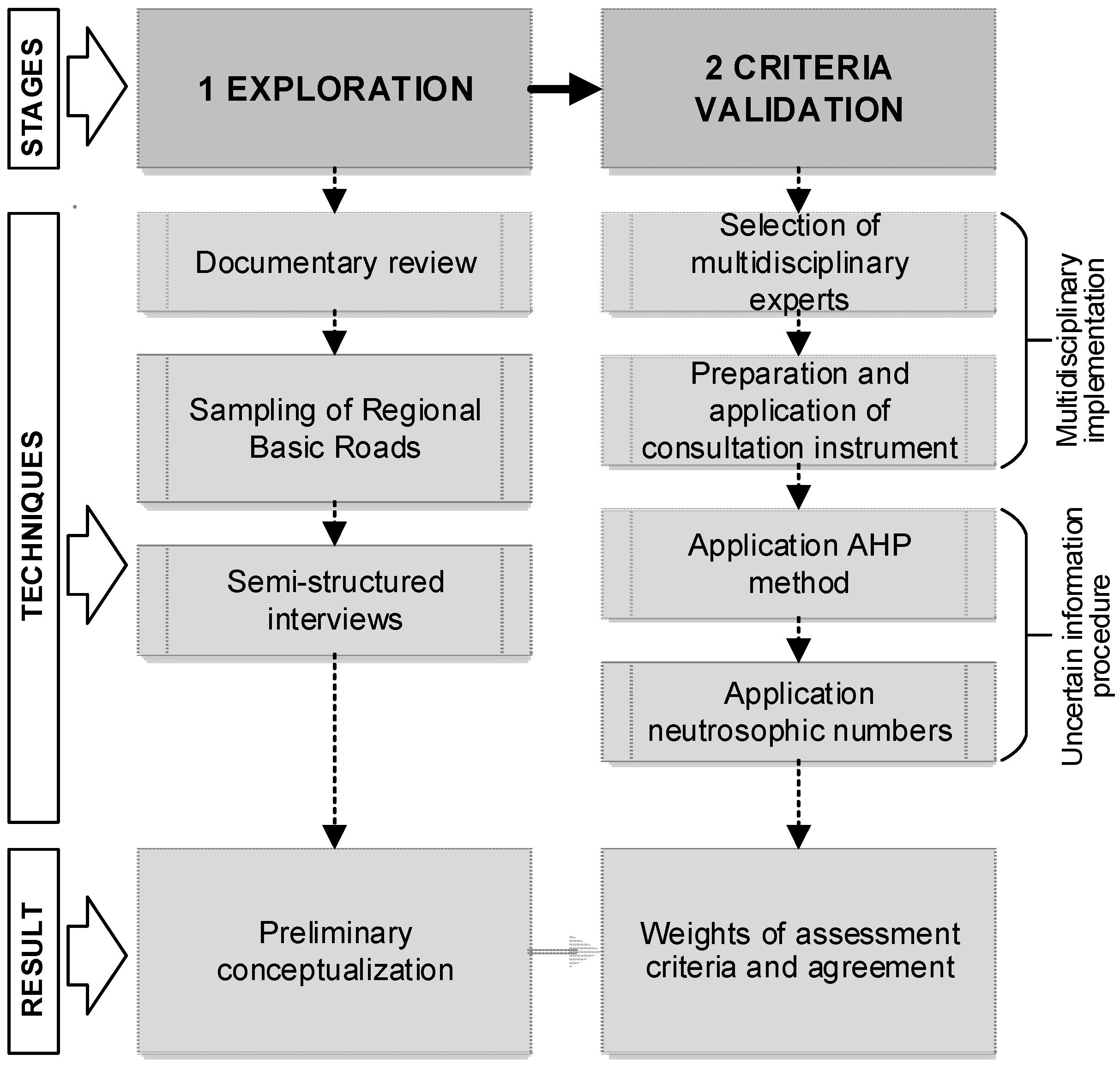
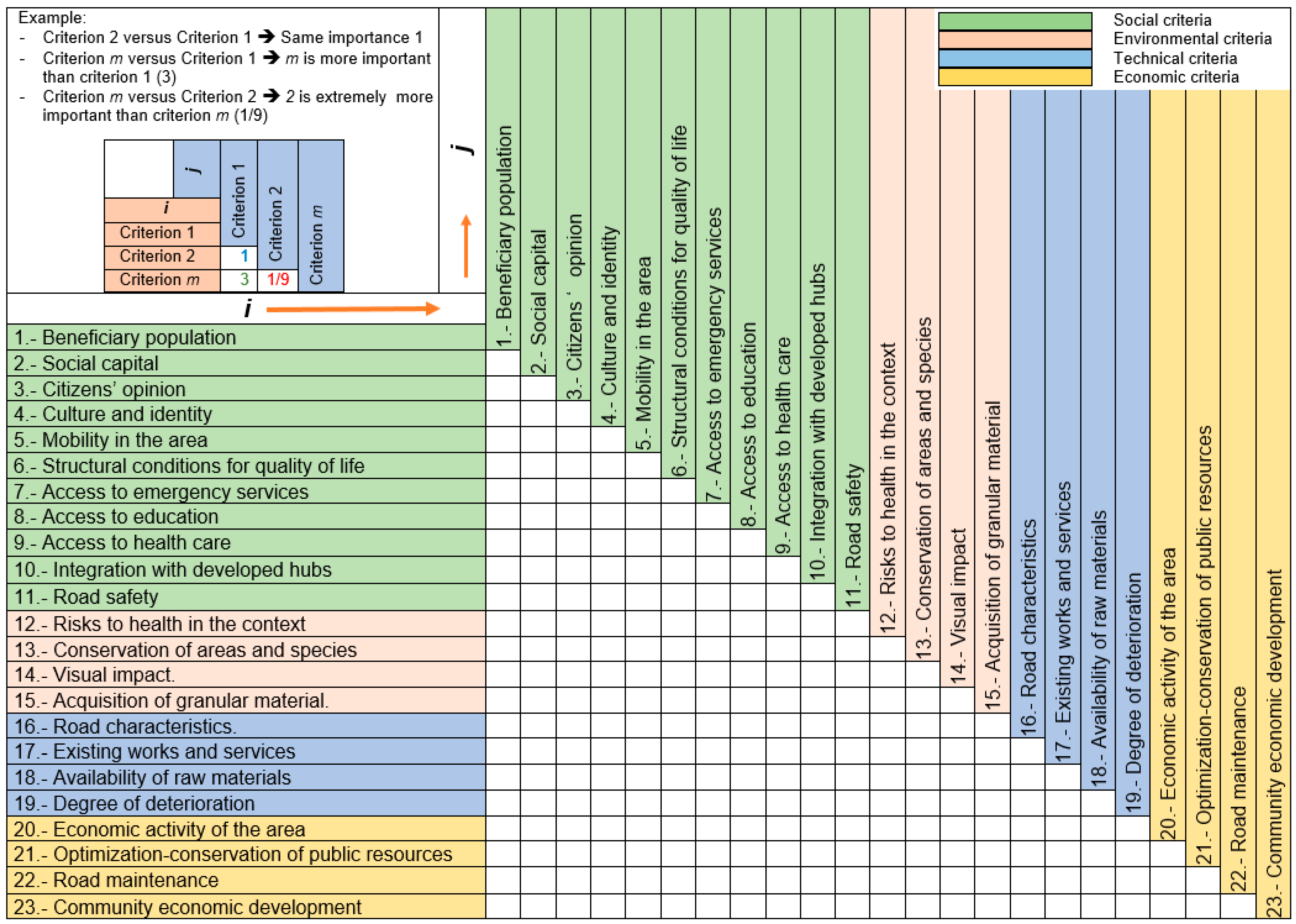
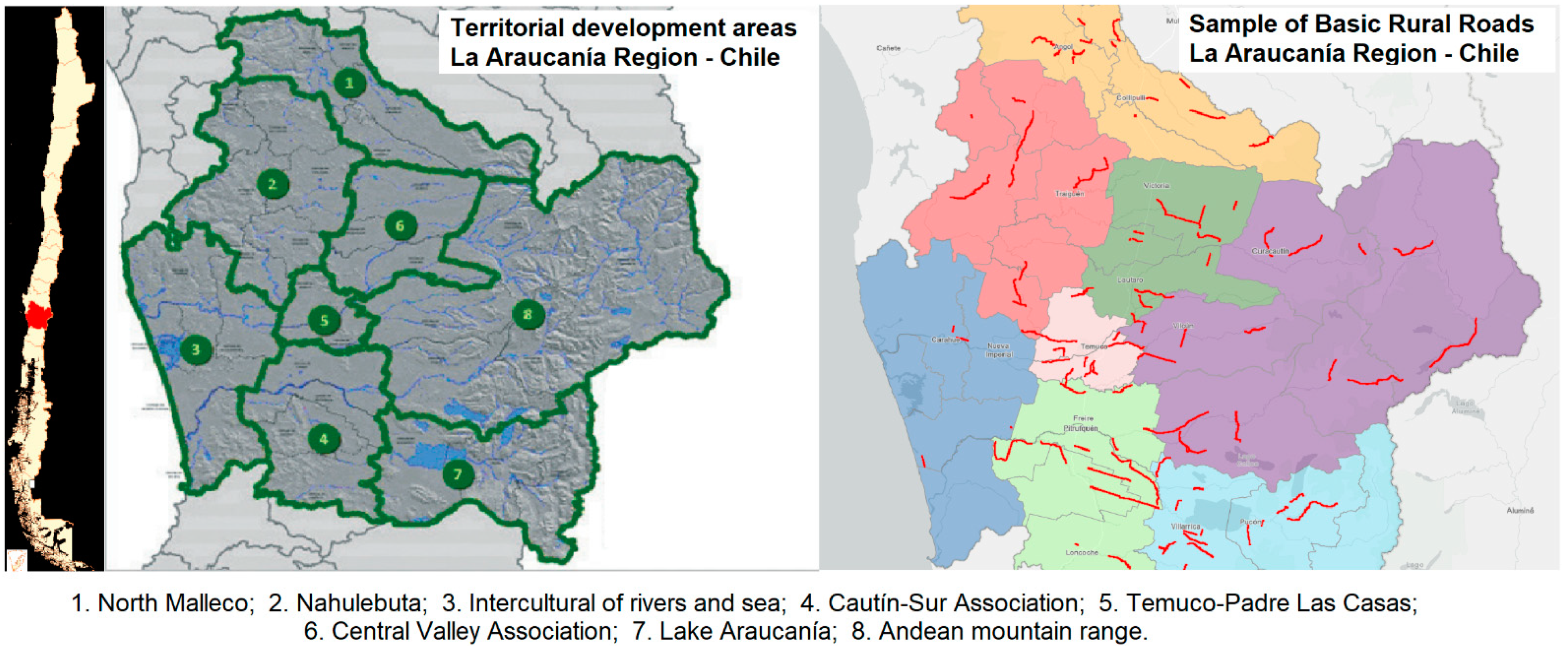
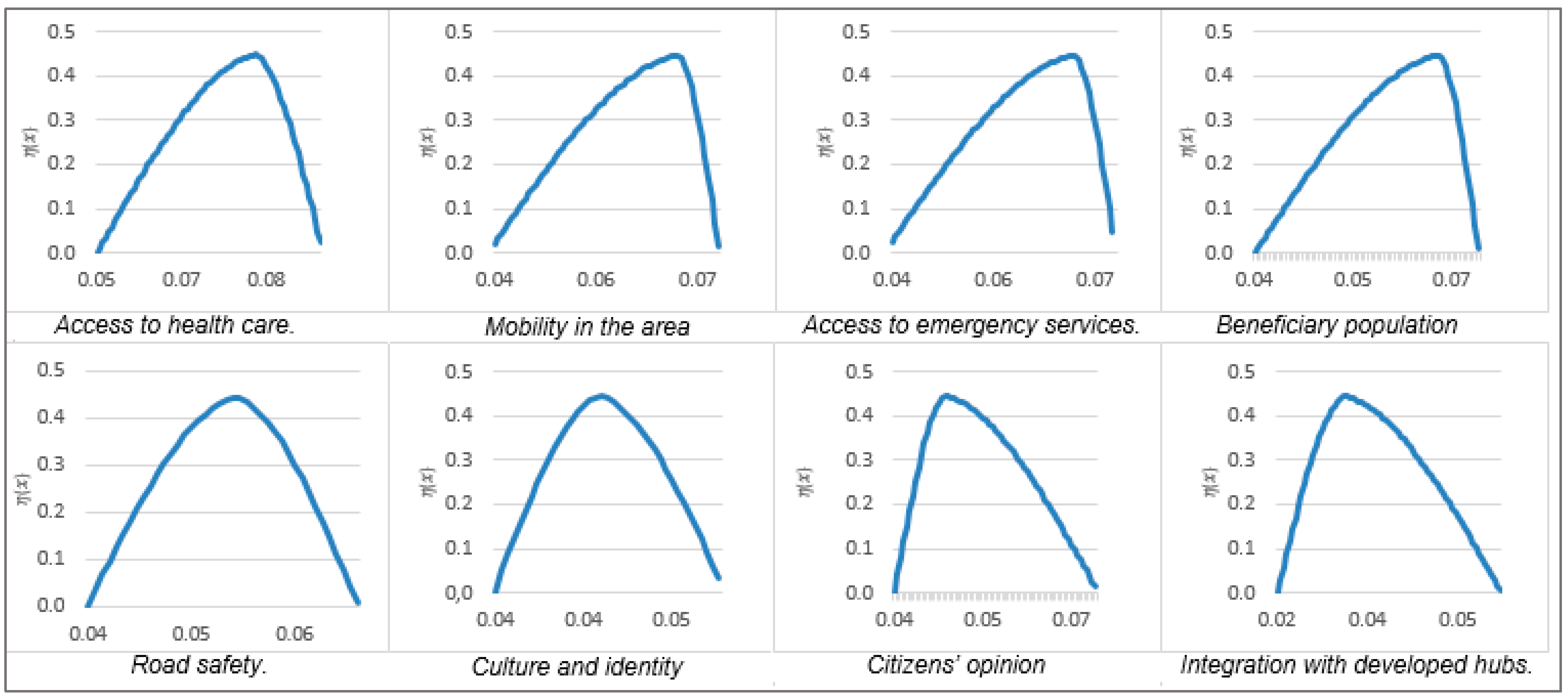
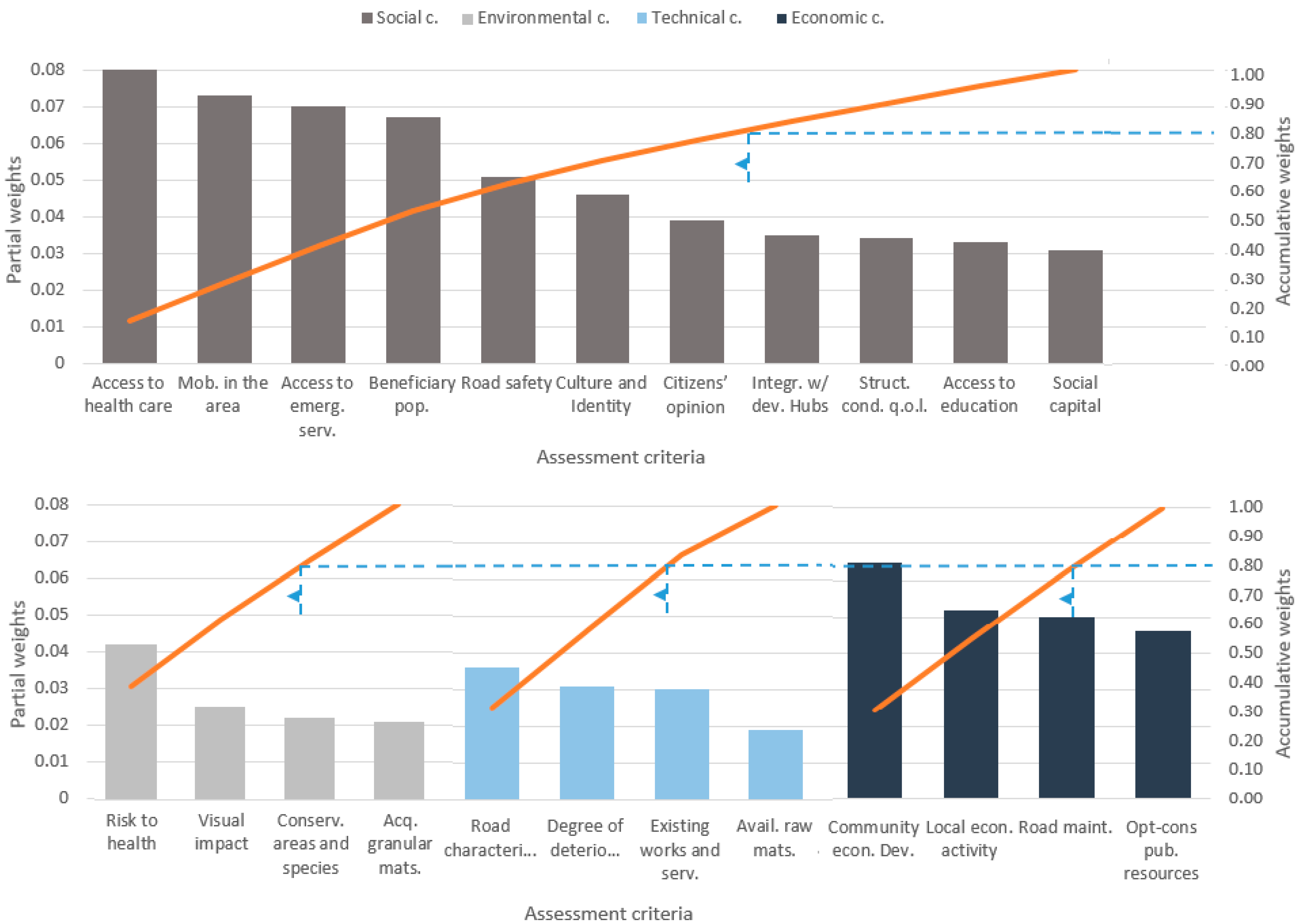
| Area of Study | Authors |
|---|---|
| Social: Citizen participation, Identity, Mobility, Education, Health, Isolation, Integration, Risks for the user, Beneficiary population, Public transport, Historical and cultural sites, Habitat fragmentation, Poverty and income, Security of the surroundings. | [4,9,10,15,19,22,36,37,38,39,40,41,42,43,44,45,46,47,48,49,50,51,52] |
| Technical: Road safety, Material acquisition, Geometry of the route, Existing infrastructure, Deterioration, Risk of disaster (flooding, earthquake), Innovation, Traffic flow, Soil movements, Hydrology. | [1,5,15,38,42,53,54,55,56,57,58,59,60,61,62,63,64] |
| Economic: Economic area activity, Use of public resources, Maintenance costs, Community economic development, Externality and cost analysis, Employment, Tourist areas, Investment cost. | [9,11,15,21,39,40,41,44,55,56,57,58,60,61,64,65,66,67,68,69,70,71,72,73,74] |
| Environmental: Landscape, Protected species, Protected areas, Health risks in the context, Green infrastructure, Recycled materials, Efficient use of water and energy resources, Reduction of emissions. | [15,36,39,40,41,42,43,44,54,56,58,59,73,75,76,77,78,79] |
| Institutional Representation | % | Education | % | Years of Experience | % |
|---|---|---|---|---|---|
| Regional Government of Araucanía | 13 | Civil Engineering | 17 | 5 to 10 | 22 |
| Ministry of Public Works—Araucanía | 17 | Geography | 9 | 11 to 15 | 26 |
| Agriculture and Livestock Service | 9 | Agronomy/Forestry | 17 | 16 to 20 | 30 |
| Regional universities [4] | 26 | Public administration | 4 | more than 20 | 22 |
| Regional NGOs [2] | 9 | Sociology | 12 | ||
| Regional oversight committees (neighbors) | 13 | Construction | 17 | ||
| Municipal departments | 13 | Pedagogy | 4 | ||
| Business Administration | 4 | ||||
| Social services | 4 | ||||
| Environmental Sciences | 12 |
| Expert | Credibility | Indetermination | Inconsistency | Relevance |
|---|---|---|---|---|
| 1 | 0.5103 | 0.3705 | 0.1600 | 0.04065 |
| 2 | 0.6217 | 0.2808 | 0.0890 | 0.04621 |
| 3 | 0.6359 | 0.2760 | 0.1050 | 0.04401 |
| 4 | 0.6375 | 0.2092 | 0.0590 | 0.04800 |
| 5 | 0.3472 | 0.5257 | 0.0820 | 0.03238 |
| 6 | 0.4113 | 0.4817 | 0.0620 | 0.03434 |
| 7 | 0.7530 | 0.1747 | 0.0710 | 0.05091 |
| 8 | 0.4577 | 0.4017 | 0.1020 | 0.03574 |
| 9 | 0.4413 | 0.4271 | 0.0610 | 0.03715 |
| 10 | 0.8489 | 0.1399 | 0.1080 | 0.05138 |
| 11 | 0.5761 | 0.2703 | 0.0290 | 0.04510 |
| 12 | 0.3500 | 0.4905 | 0.0920 | 0.03354 |
| 13 | 0.3072 | 0.4195 | 0.0530 | 0.03742 |
| 14 | 0.5456 | 0.3975 | 0.1010 | 0.04064 |
| 15 | 0.7621 | 0.2601 | 0.0440 | 0.04880 |
| 16 | 0.6834 | 0.3220 | 0.0610 | 0.04687 |
| 17 | 0.1398 | 0.3875 | 0.1340 | 0.02753 |
| 18 | 0.5825 | 0.2930 | 0.1230 | 0.04366 |
| 19 | 0.5161 | 0.4611 | 0.0600 | 0.03937 |
| 20 | 0.7587 | 0.3261 | 0.0860 | 0.04639 |
| 21 | 0.5946 | 0.2820 | 0.0610 | 0.04137 |
| 22 | 0.6287 | 0.2661 | 0.0860 | 0.04212 |
| 23 | 0.7265 | 0.2691 | 0.1630 | 0.04661 |
| 24 | 0.5814 | 0.3538 | 0.0460 | 0.03983 |
| Criterion | Criterion | ||||||||||||
|---|---|---|---|---|---|---|---|---|---|---|---|---|---|
| 1 | 0.06 | 0.07 | 0.07 | 0.05 | 0.04 | 0.04 | 13 | 0.01 | 0.01 | 0.01 | 0.05 | 0.04 | 0.04 |
| 2 | 0.02 | 0.02 | 0.02 | 0.04 | 0.04 | 0.04 | 14 | 0.01 | 0.01 | 0.01 | 0.05 | 0.04 | 0.04 |
| 3 | 0.06 | 0.07 | 0.07 | 0.05 | 0.04 | 0.04 | 15 | 0.02 | 0.02 | 0.02 | 0.04 | 0.04 | 0.04 |
| 4 | 0.04 | 0.04 | 0.05 | 0.04 | 0.04 | 0.04 | 16 | 0.06 | 0.07 | 0.07 | 0.05 | 0.04 | 0.04 |
| 5 | 0.06 | 0.07 | 0.07 | 0.05 | 0.04 | 0.04 | 17 | 0.01 | 0.01 | 0.01 | 0.06 | 0.04 | 0.04 |
| 6 | 0.03 | 0.03 | 0.03 | 0.03 | 0.04 | 0.04 | 18 | 0.02 | 0.02 | 0.02 | 0.04 | 0.04 | 0.04 |
| 7 | 0.06 | 0.07 | 0.07 | 0.05 | 0.04 | 0.04 | 19 | 0.06 | 0.07 | 0.07 | 0.05 | 0.04 | 0.04 |
| 8 | 0.02 | 0.02 | 0.02 | 0.04 | 0.04 | 0.04 | 20 | 0.06 | 0.07 | 0.07 | 0.05 | 0.04 | 0.04 |
| 9 | 0.06 | 0.07 | 0.07 | 0.05 | 0.04 | 0.04 | 21 | 0.01 | 0.01 | 0.01 | 0.05 | 0.04 | 0.04 |
| 10 | 0.03 | 0.03 | 0.03 | 0.03 | 0.04 | 0.04 | 22 | 0.01 | 0.01 | 0.01 | 0.05 | 0.04 | 0.04 |
| 11 | 0.04 | 0.04 | 0.05 | 0.04 | 0.04 | 0.04 | 23 | 0.09 | 0.11 | 0.11 | 0.05 | 0.04 | 0.04 |
| 12 | 0.06 | 0.07 | 0.07 | 0.05 | 0.04 | 0.04 | -- | ||||||
| Criterion | Lowest | Middle | Highest | Truth | Indetermination | Falsehood |
|---|---|---|---|---|---|---|
| 1 | 0.039 | 0.067 | 0.073 | 0.044 | 0.043 | 0.043 |
| 2 | 0.030 | 0.038 | 0.065 | 0.043 | 0.043 | 0.043 |
| 3 | 0.036 | 0.041 | 0.045 | 0.042 | 0.043 | 0.043 |
| 4 | 0.037 | 0.046 | 0.057 | 0.042 | 0.043 | 0.043 |
| 5 | 0.043 | 0.071 | 0.077 | 0.044 | 0.043 | 0.043 |
| 6 | 0.028 | 0.033 | 0.069 | 0.044 | 0.043 | 0.043 |
| 7 | 0.039 | 0.067 | 0.073 | 0.045 | 0.043 | 0.043 |
| 8 | 0.026 | 0.032 | 0.058 | 0.044 | 0.043 | 0.043 |
| 9 | 0.050 | 0.078 | 0.090 | 0.047 | 0.043 | 0.043 |
| 10 | 0.023 | 0.034 | 0.060 | 0.041 | 0.043 | 0.043 |
| 11 | 0.041 | 0.051 | 0.060 | 0.043 | 0.043 | 0.043 |
| 12 | 0.034 | 0.040 | 0.050 | 0.043 | 0.043 | 0.043 |
| 13 | 0.017 | 0.020 | 0.046 | 0.046 | 0.043 | 0.043 |
| 14 | 0.016 | 0.022 | 0.058 | 0.045 | 0.043 | 0.043 |
| 15 | 0.018 | 0.020 | 0.046 | 0.044 | 0.043 | 0.043 |
| 16 | 0.026 | 0.037 | 0.042 | 0.043 | 0.043 | 0.043 |
| 17 | 0.032 | 0.036 | 0.041 | 0.042 | 0.043 | 0.043 |
| 18 | 0.009 | 0.019 | 0.026 | 0.044 | 0.043 | 0.043 |
| 19 | 0.026 | 0.030 | 0.056 | 0.043 | 0.043 | 0.043 |
| 20 | 0.043 | 0.054 | 0.061 | 0.042 | 0.043 | 0.043 |
| 21 | 0.018 | 0.046 | 0.052 | 0.043 | 0.043 | 0.043 |
| 22 | 0.023 | 0.051 | 0.058 | 0.043 | 0.043 | 0.043 |
| 23 | 0.038 | 0.066 | 0.072 | 0.044 | 0.043 | 0.043 |
Publisher’s Note: MDPI stays neutral with regard to jurisdictional claims in published maps and institutional affiliations. |
© 2021 by the authors. Licensee MDPI, Basel, Switzerland. This article is an open access article distributed under the terms and conditions of the Creative Commons Attribution (CC BY) license (https://creativecommons.org/licenses/by/4.0/).
Share and Cite
Sierra, L.; Araya, F.; Yepes, V. Consideration of Uncertainty and Multiple Disciplines in the Determination of Sustainable Criteria for Rural Roads Using Neutrosophic Logic. Sustainability 2021, 13, 9854. https://doi.org/10.3390/su13179854
Sierra L, Araya F, Yepes V. Consideration of Uncertainty and Multiple Disciplines in the Determination of Sustainable Criteria for Rural Roads Using Neutrosophic Logic. Sustainability. 2021; 13(17):9854. https://doi.org/10.3390/su13179854
Chicago/Turabian StyleSierra, Leonardo, Felipe Araya, and Víctor Yepes. 2021. "Consideration of Uncertainty and Multiple Disciplines in the Determination of Sustainable Criteria for Rural Roads Using Neutrosophic Logic" Sustainability 13, no. 17: 9854. https://doi.org/10.3390/su13179854
APA StyleSierra, L., Araya, F., & Yepes, V. (2021). Consideration of Uncertainty and Multiple Disciplines in the Determination of Sustainable Criteria for Rural Roads Using Neutrosophic Logic. Sustainability, 13(17), 9854. https://doi.org/10.3390/su13179854








